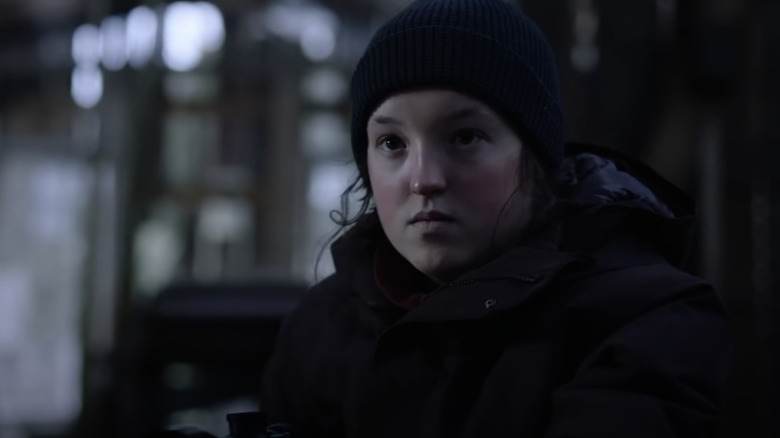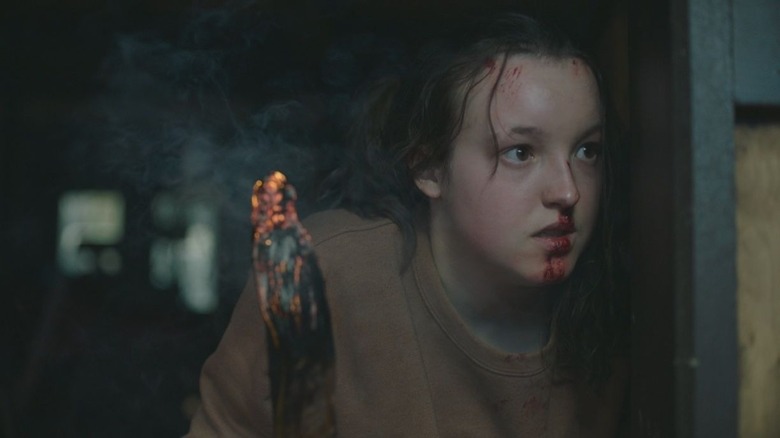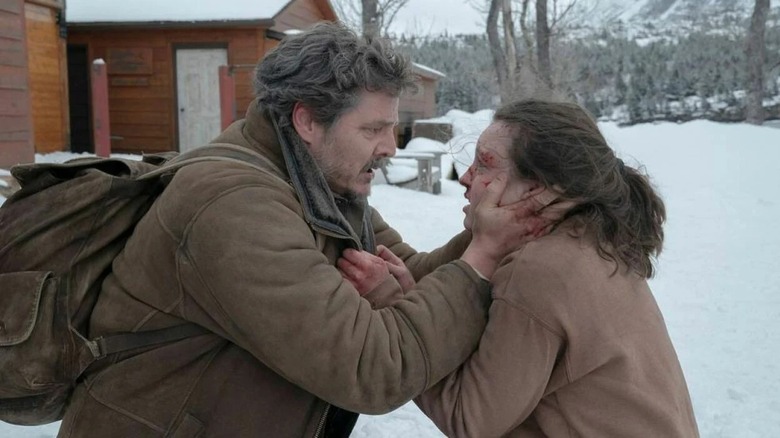The Last Of Us Makes A Brutal Death From The Game Even Harder To Watch
This post contains major spoilers for "The Last of Us" episode 8.
This week's episode of "The Last of Us" is a pitch-perfect adaptation of one of the most harrowing sequences in the original game, in which Ellie (Bella Ramsey) looks after a wounded and healing Joel (Pedro Pascal) in the middle of a cruel winter. As she hunts for food and supplies, all hell breaks loose once she encounters David (Scott Shepherd) and James (Troy Baker, a familiar actor to gamers everywhere).
He may not look like much at first, but David, the preacher/leader of a quaint community living in an abandoned mountainside resort, is harboring a dark secret from his people. The series brings some fresh updates to David's origins and motivations, adding a haunting layer of realism to the character, solidifying him as one of the most disturbing antagonists in "The Last of Us" universe.
We've seen 14-year-old Ellie at her most innocent and vulnerable. We've also seen glimpses at something darker within her in equal measure. Under Joel's protection, he made a commitment to protect his surrogate child from having to partake in excessive acts of violence, but in the final moments of "When We Are In Need," Ellie is forced to cross that threshold alone in the act of survival. As David preys on Ellie, she takes a cleaver to his face — many, many, times.
Though the scene is mostly taken straight from the 2013 game, it feels especially hard to watch in live-action. On the official "The Last of Us" HBO Podcast, showrunners Craig Mazin and Neil Druckmann broke down the scene and why it feels so violating to watch, and explained their motivations behind some small staging differences.
Live-action emphasizes the brutal details
There are a number of factors why the HBO adaptation's take on this scene feels even more tense than the game's version, despite the framing being relatively the same (including a bloody lens effect that both scenes share). For one, David's creepy, sexual fascination with Ellie is made even more explicit than the subtle references we got in the original scene, so there's an added sense of urgency there. For others, it might be the fact that seeing Ellie cleave David in CG animation feels less visceral than watching the scene play out in live action, where there's more of an emphasis on Ellie's youth because of Bella Ramsey's screen presence.
Craig Mazin shared his own reaction to the scene on the podcast:
"... part of it is that there's that one less thing of separation between you and reality because it's not animated. It's a person. Because there is blood flying everywhere, including hitting the lens. And then it's also just telling Bella, 'You have no restraints. You have no leash. You have no nothing. Just do what needs to be done.' And when she kills him, it's so clear that he is beyond dead after this fifth or sixth blow. And she keeps going. And then she slows down. And then she starts up again. And it's that moment where you realize that there's just everything pouring out of her. And when she finally stops, and she looks off, it's — I don't know how you could portray trauma better, more convincingly, more accurately than what is on her face in that moment and what is in her eyes. It is so upsetting."
A logistical staging change
In the original game's staging, Ellie is interrupted by Joel in the burning restaurant, then the pair share a hug as the dialogue in the scene goes mute — words are shared just between our two protagonists to hear in their intimate exchange. In the series, Ellie walks out of the burning restaurant to find Joel in the snow. When asked why this change was made, Druckmann and Mazin admitted it was more of a logistical choice at first. "I think our conversations were like, we didn't want it to happen with the fire around," Druckmann admitted. "Like, there's the danger of the fire that just felt a little different in live action than it did in the game."
"Yeah, there was a question of, like, 'How does Joel get inside if the keys are on David?' It was like a little bit of a logic thing," Mazin continued, "and then it was a little bit of, like, wanting our Ellie to have completed it to the point where she could literally walk away on her own."
Though I disagreed with the choice to prioritize logic over emotion, the new staging does allow for a unique moment that wasn't in the game — Ellie eventually stops cleaving David and looks at what she has done. More than it ever was in the original scene, this was a moment of complete release of the pain Ellie has endured throughout the season. As much as this is about killing David, it's also a form of vengeance. This is about Riley, Tess, Henry, and Sam. Ellie's act of violence is her temporary moment of catharsis, in this fleeting moment, Ellie has the power in the situation. She's horrified at what she's done, but also thrilled.
Joel may be her protector, but Ellie saves herself
Despite the change in staging, Mazin and Druckmann kept what was essential about the scene. This is a moment of evolution for Ellie, and a crucial memory that informs the person she becomes when she's older. The memory of killing David is something that stays with her past when the credits roll and the seasons change. It's also an important subversion of expectations, as Druckmann explains:
"... we want the audience or the player — to think Joel is going to save Ellie. Because that's what this character traditionally does. And it was important that, "No, no, no — Ellie saves herself. Except that he does save her. But now he has to do a very different thing that a parent does, which is he saves her emotionally."
Joel and Ellie's entire journey across an apocalyptic America has been scarred by tragedy, but this episode defines their lowest point. Still, it's also the moment that solidifies their father/daughter bond, with Joel's delivery of "baby girl."
"The Last of Us" airs Sundays at 9/8c on HBO and HBO Max.


